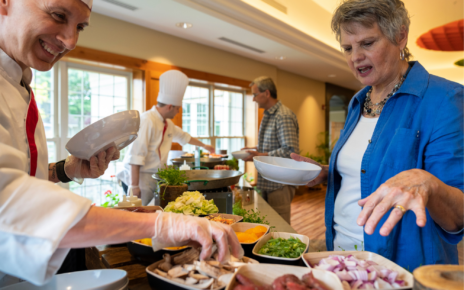By OLIVIA MASTRY, JD, MPH, COLLECTIVE ACTION LAB, COLLECTIVEACTIONLAB.COM
History has shown us that viruses spur evolution. Perhaps we should see COVID-19 as a gateway to a new era that we can strategically influence to create better health and well-being for people and the planet. To this end, we should be watching for “wet clay” opportunities in which previously intractable, set-in-stone issues can be re-imagined and re-molded to create a better future.
A few areas of emerging next normals where we can ask ourselves, “what could this mean for us – and what can we do about it?” include:
WORKPLACE EVOLUTION
As the workforce has become more comfortable with remote work and enabling automation, many aspects of remote working may become permanent, and traditional offices and work spaces may radically change.
RESILIENCY VERSUS EFFICIENCY
In recent history, our focus has been on quick, cheap production and ever-increasing consumption (the “efficiency model”). As a result of COVID-19, people, organizations, and governments are increasingly seeking resiliency by relying more on local and regional rather than global supply chains, engaging in less risky transactions, and generally existing more frugally and simply.
CORPORATE ACCOUNTABILITY
As COVID-19 has made the wealth and power gap even more obvious than it already was, corporations are increasingly coming under public scrutiny, not just with respect to profits, but the whole “triple P” — profits, treatment of people, and impact on the planet.
EQUITY REVOLUTION
COVID-19 made it impossible to deny the historical trauma and deep inequities created through 400 years of racism that is now baked into our systems and society. The murder of George Floyd catalyzed a citizen uprising that could morph into a revolution that demands and brings about rapid systemic changes to dismantle barriers to equity in all aspects of our lives.
LIVING ONLINE
For those of us with access to internet service and a camera on our phones, iPads or tablets, we are doing almost everything online — both personally and professionally. As internet usage becomes fundamental to existence and connection to civic society, questions arise about whether it should be a public utility to close rural/urban, wealth, and other equity-based access gaps.
MUTUAL AID
Throughout the racial injustice uprisings, we are seeing dominant culture relief organizations replaced by a strengthened, organic, neighbor-to-neighbor mutual aid network. As the network grows, so does the potential for what it can achieve beyond emergency response to activate and catalyze citizen movements for change.
TAIL RISK MINDFULNESS
Challenged stay-at-home orders, mask mandates, and economic re-openings have shown that we have an on-again, off-again relationship with thinking about, responding to, or ignoring the future impact of our actions. Currently, it is unclear whether tail risk mindfulness is a muscle we want to build or let atrophy.
GOVERNMENT INTERVENTION
Citizen surveillance, state-federal powers, relief and stimulus packages, and the role of the central bank are all raising continual questions about how much power, intervention, and authoritarianism we want and can tolerate in government.
NEW SOCIAL CONTRACTS
We are continually testing new precedents that might provide the basis of re-writing social contracts in our country, such as universal basic income — the first relief package made direct payments to citizens; national health insurance — in response to large scale and sustained unemployment; and deeper investments in a stronger public health infrastructure — to prepare us for the next virus.
NEW HEROES
Everyday service and delivery workers have proved vital to our daily well-being, which could/should justify better wages, protections, and employee-owned companies.
PUBLIC-PRIVATE PARTNERSHIPS
The race for protective gear and a vaccine has shown new levels of engagement and partnership between public and private organizations that may become the norm as we collectively seek solutions together.
Moving from a societal level to an aging/senior services sector level raises similar “wet clay” opportunity questions. A few areas of emerging next normals that might open the door to needed reforms include:
WORKFORCE
Using the COVID-19-enhanced valuing of caregivers to leverage workforce changes such as redesign, new delegation authorities, increased wages, career ladders, work flexibility, accessing a pipeline of workers from other industries, and new roles for retirees and volunteers.
TECHNOLOGY-ENABLED CARE
Solidifying sustained telehealth and other technology-enabled care.
ALTERNATIVE MODELS
Responding creatively to the post-COVID-19 increased demand for home and community-based care.
SOCIAL CONTRACTS
Weaving and embedding financing for long term services and supports into any new social contract that relates to national health insurance.
VISIBILITY OF SOCIAL ISOLATION
Leveraging the fact that social isolation is now an “everyone” issue to advocate for connectivity and technology access for older adults, including pursuing internet access as a public utility.
PUBLIC-PRIVATE PARTNERSHIPS
Replicating COVID-19-style partnerships can be replicated in senior services to establish and pursue shared goals that benefit older adults.
ADDITIONAL RESOURCES
Often times in crises, people respond with fear or are reminded of past trauma that can immobilize their ability to engage in “wet clay” thinking. The links below could be helpful in responding to and supporting people when they experience fears or past trauma.
• SAMHA Guidance on Trauma-Informed Approaches
• Trauma Informed Oregon
• Resilient Wisconsin
• Mindfulness when facing pandemic fear




